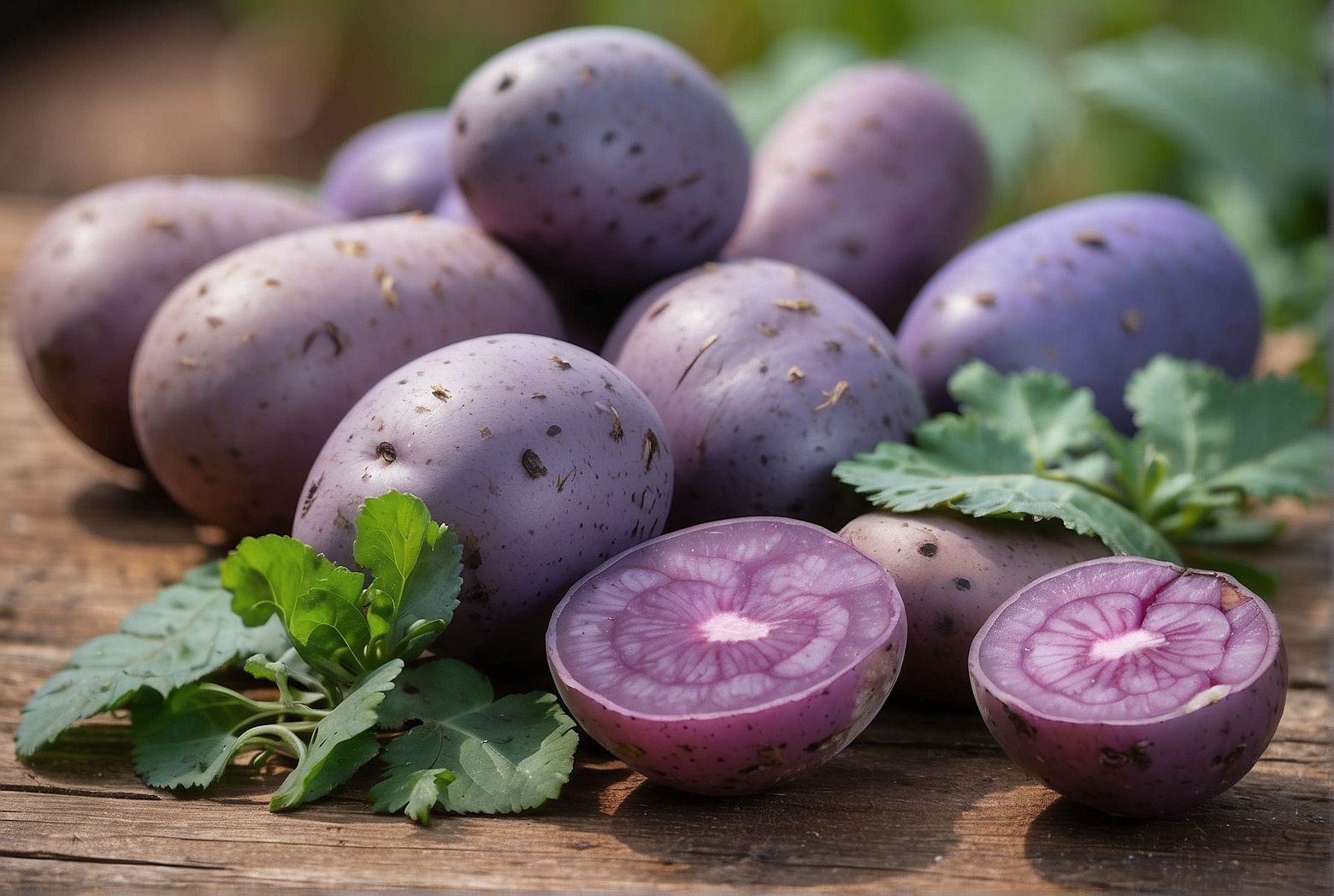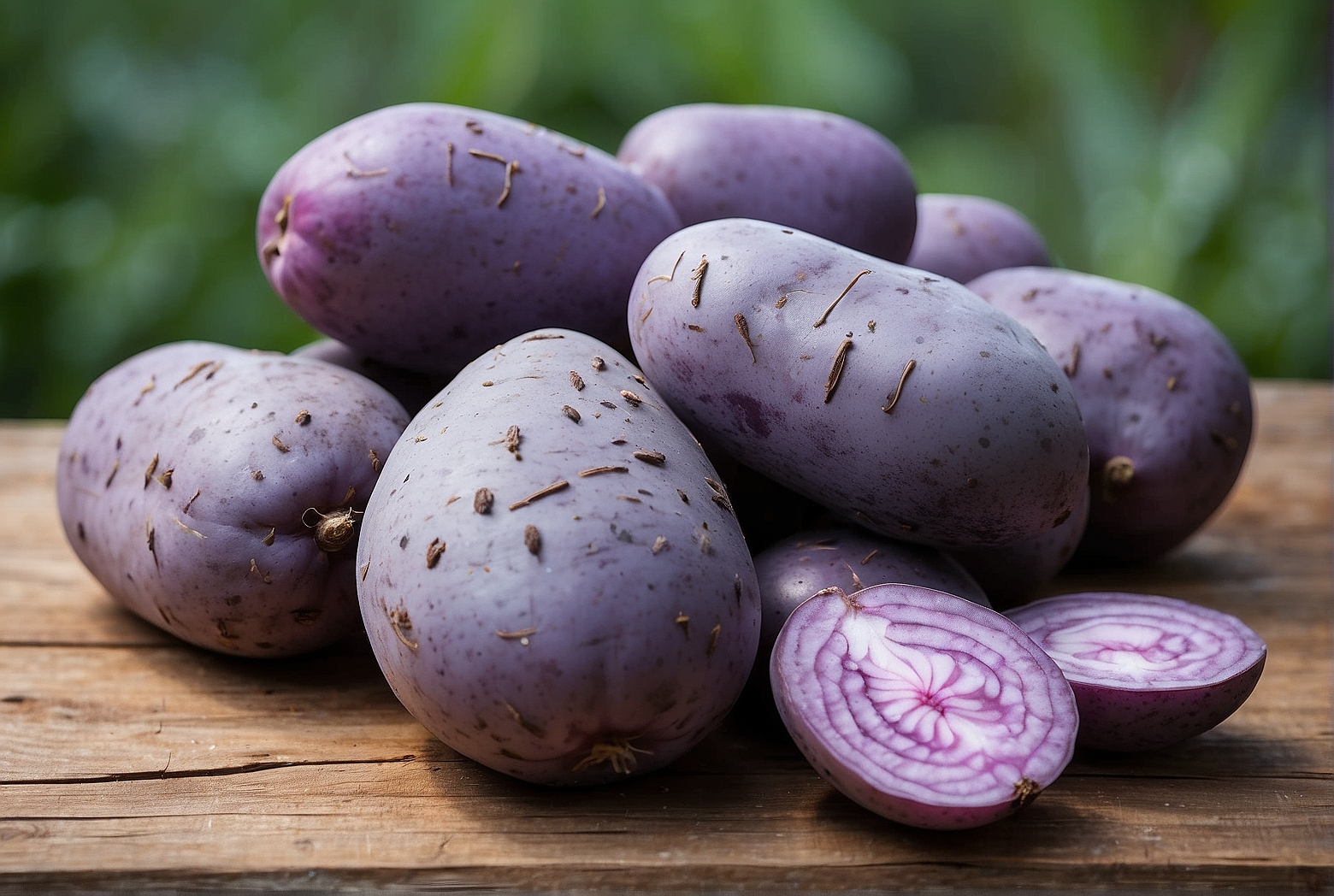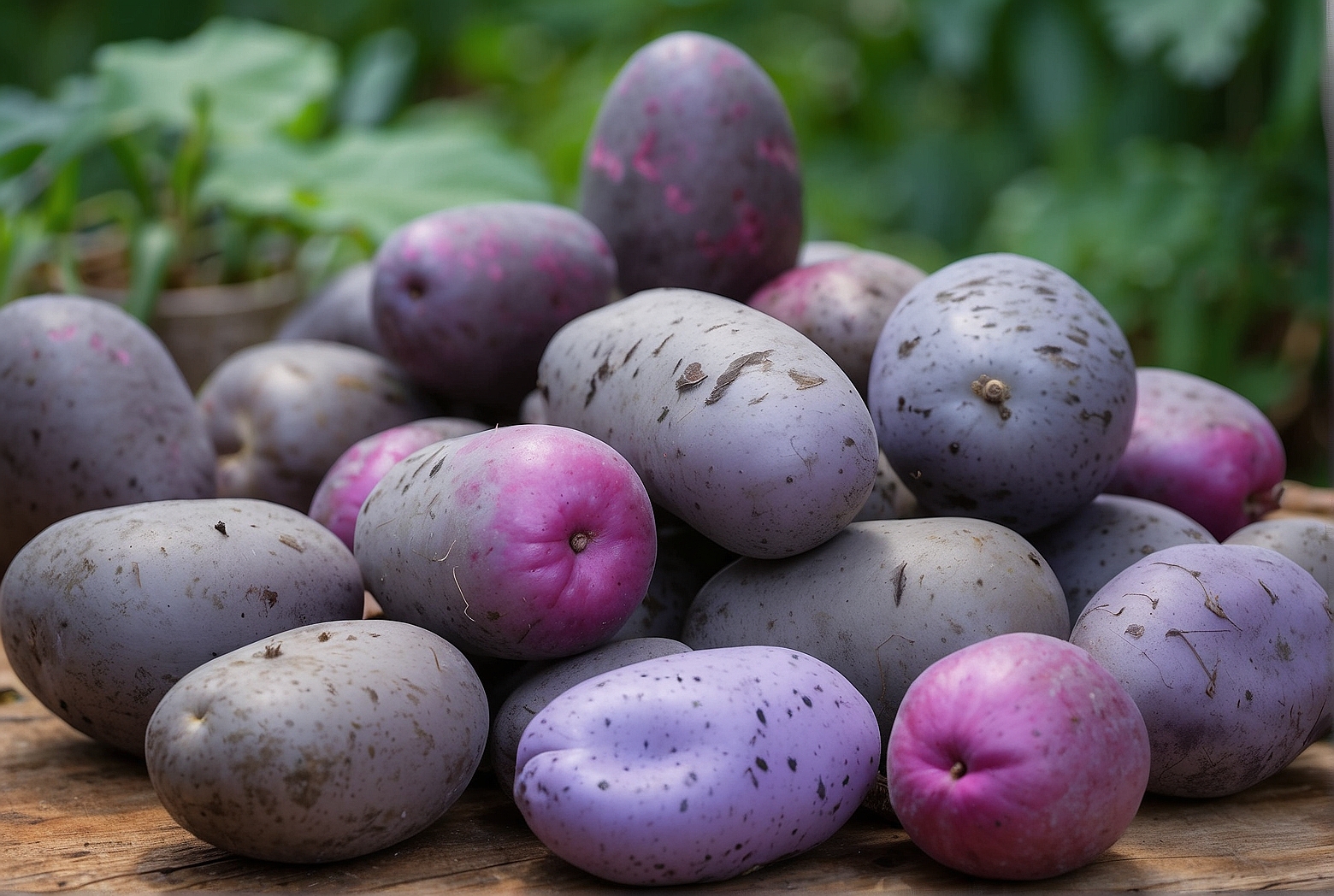Last Updated on April 6, 2024 by Tony Manhart
Adirondack Blue Potatoes are not just your everyday spuds. These unique tubers have a striking indigo hue that sets them apart from the traditional brown-skinned varieties. But their allure doesn’t end with their eye-catching appearance. In this article, we will explore the characteristics of Adirondack Blue Potatoes, uncovering their flavor profile, nutritional benefits, and the best cooking methods to bring out their vibrant purple color. Get ready to embark on a flavorful journey with these fascinating blue potatoes!
What are Adirondack Blue Potatoes?
Adirondack Blue Potatoes are a distinctive variety of potatoes known for their vibrant blue-purple color. These potatoes have a unique appearance and taste, making them a popular choice for both culinary and nutritional purposes. In this article, we will explore the origin, history, growth, cultivation, nutritional profile, health benefits, cooking methods, storage techniques, culinary uses, cultivation tips, and considerations for sustainable farming of Adirondack Blue Potatoes.
Origin and History
Adirondack Blue Potatoes were first developed by Cornell University’s plant breeding program in the 1970s. The breeding program aimed to create potatoes with enhanced nutritional profiles and unique pigmentation. Adirondack Blue Potatoes were the result of crossbreeding between a standard white potato and a heirloom blue potato. The vibrant blue color is due to the presence of anthocyanins, which are powerful antioxidants found in various fruits and vegetables.
Appearance and Taste
Adirondack Blue Potatoes are instantly recognizable due to their striking blue-purple coloration. The skin and flesh of these potatoes have a deep blue hue, which remains even after cooking. In terms of texture, Adirondack Blue Potatoes are firm, dense, and moist. When cooked, they maintain their shape well and have a smooth and creamy texture. As for taste, these potatoes offer a slightly nutty flavor with subtle earthy undertones, making them a versatile and flavorful ingredient in various dishes.

Growth and Cultivation
Adirondack Blue Potatoes are relatively easy to grow and are known for their adaptability to different climates. They belong to the Solanaceae family and require similar growing conditions as other potato varieties. These potatoes thrive in well-draining soil with a pH level between 5.0 and 7.0. Adequate sunlight, regular watering, and proper spacing can promote healthy growth and higher yields. Adirondack Blue Potatoes can be grown from seeds or seed potatoes, and the entire growing process usually takes around three to four months, depending on the specific climate and growing conditions.
Nutritional Profile of Adirondack Blue Potatoes
Adirondack Blue Potatoes offer an impressive nutritional profile, making them a wholesome addition to any diet. Let’s take a closer look at the essential nutrients found in these potatoes.
Calories
A medium-sized Adirondack Blue Potato contains approximately 130 calories. It is important to note that calorie content can vary based on the size and preparation method of the potato.
Carbohydrates
Adirondack Blue Potatoes are an excellent source of carbohydrates, providing energy for the body. A medium-sized potato contains around 30 grams of carbohydrates, including dietary fiber.

Protein
While Adirondack Blue Potatoes are not a significant source of protein, they do contain a small amount. A medium-sized potato provides approximately 2 grams of protein.
Fat
Adirondack Blue Potatoes are naturally low in fat. A medium-sized potato contains less than half a gram of fat.
Dietary Fiber
These potatoes are a good source of dietary fiber, which plays a crucial role in supporting digestive health. A medium-sized Adirondack Blue Potato offers roughly 4 grams of dietary fiber.
Vitamins and Minerals
Adirondack Blue Potatoes are rich in various vitamins and minerals. They are a good source of vitamin C, vitamin B6, potassium, and manganese. Additionally, they contain smaller amounts of iron, magnesium, and folate.
Health Benefits of Adirondack Blue Potatoes
Beyond their appealing taste, Adirondack Blue Potatoes provide numerous health benefits. Let’s explore some of the potential advantages they offer.
Antioxidant Properties
The deep blue color of Adirondack Blue Potatoes indicates the presence of anthocyanins, which are powerful antioxidants. These antioxidants help protect the body against harmful free radicals, thereby reducing the risk of chronic diseases and promoting overall well-being.
Reduced Inflammation
Adirondack Blue Potatoes contain compounds that possess anti-inflammatory properties. Regular consumption of these potatoes may help alleviate inflammation within the body, reducing the risk of chronic conditions such as heart disease, diabetes, and certain types of cancer.
Improved Digestive Health
With their significant dietary fiber content, Adirondack Blue Potatoes can contribute to a healthy digestive system. Fiber promotes regular bowel movements, prevents constipation, and supports a balanced gut microbiome.
Cardiovascular Health
The combination of antioxidants and dietary fiber in Adirondack Blue Potatoes is beneficial for cardiovascular health. Antioxidants help reduce oxidative stress, a primary factor in heart disease development, while dietary fiber assists in maintaining healthy cholesterol levels.
Better Cognitive Function
The anthocyanins found in Adirondack Blue Potatoes have been associated with improved cognitive function and memory. Regular consumption of these potatoes may help protect against age-related cognitive decline and support brain health.
Cooking with Adirondack Blue Potatoes
Adirondack Blue Potatoes are incredibly versatile in the kitchen and can be used in various dishes. Here are some preparation and cooking methods, as well as recipe ideas to unleash the potential of these potatoes.
Preparation and Cooking Methods
To prepare Adirondack Blue Potatoes, start by thoroughly washing and scrubbing them under cold water. The skin is edible and adds to the aesthetic appeal, but it can be peeled if preferred. These potatoes can be boiled, roasted, mashed, grilled, or used in soups and stews. Avoid overcooking, as it can result in a mushy texture.
Recipes and Ideas
- Mashed Adirondack Blue Potatoes: Boil the potatoes until tender, then mash them with butter, salt, and pepper for a flavorful side dish.
- Adirondack Blue Potato Fries: Cut the potatoes into strips, toss them with olive oil, salt, and your choice of seasonings, then bake until crispy for a healthier alternative to traditional french fries.
- Adirondack Blue Potato Salad: Boil the potatoes, cut them into cubes, and mix with mayonnaise, mustard, boiled eggs, pickles, and herbs for a delicious and colorful potato salad.
- Adirondack Blue Potato Gratin: Layer thinly sliced potatoes with cheese, cream, and herbs, then bake until golden and bubbly for an indulgent gratin.
- Adirondack Blue Potato Soup: Simmer the potatoes with onions, garlic, and vegetable broth, then blend until smooth for a comforting and satisfying soup.
Storage and Shelf Life
Proper storage techniques are crucial for maximizing the shelf life of Adirondack Blue Potatoes.
Proper Storage Techniques
Store Adirondack Blue Potatoes in a cool, dark, and well-ventilated place, such as a pantry or cellar. Avoid exposing them to direct sunlight or high temperatures, as this can cause sprouting and spoilage. It is recommended to store them in paper or burlap bags, which allow for air circulation and prevent condensation.
Shelf Life
When stored correctly, Adirondack Blue Potatoes can last for several weeks to a couple of months. Regularly inspect the potatoes and remove any that show signs of rot or decay to prevent spoilage from spreading to the rest of the batch.
Adirondack Blue Potatoes in Culinary Uses
The unique color and taste of Adirondack Blue Potatoes make them an excellent choice for various culinary applications. Let’s explore some popular ways to incorporate these potatoes into your meals.
Mashed Potatoes
Adirondack Blue Potatoes make vibrant and visually appealing mashed potatoes. Their natural blue color can enhance the presentation of the dish and add a pop of color to your table.
Fries and Chips
Slice Adirondack Blue Potatoes into thin strips or rounds to create crispy and colorful fries or chips. These make a fun and nutritious snack or a delicious side dish.
Salads
Incorporate Adirondack Blue Potatoes into salads to add both flavor and visual interest. Their striking blue hue can elevate the overall appearance of the dish.
Casseroles and Gratins
Adirondack Blue Potatoes work well in baked casseroles and gratins. Their creamy texture and vibrant color make them an attractive addition to any dish.
Soups and Stews
Add Adirondack Blue Potatoes to soups and stews to introduce their unique flavor and color to hearty and comforting meals. They can add a rich and earthy element to these dishes.
Adirondack Blue Potatoes in Cultivation
If you’re interested in growing your own Adirondack Blue Potatoes, here are some tips for successful cultivation.
Planting and Growing Tips
Start by obtaining good-quality seed potatoes from a trusted source or save your own from previous harvests. Prior to planting, allow the seed potatoes to sprout in a warm and well-lit area for a few weeks. When planting, ensure the soil is well-drained and fertile. Plant the seed potatoes in shallow trenches, approximately 4 inches apart, and cover them with a thin layer of soil. As the plants grow, gradually mound up soil around them to protect emerging tubers from sunlight, which can lead to greening. Regularly water the plants, ensuring they receive 1 to 2 inches of water per week.
Harvesting and Storing Seeds
Adirondack Blue Potatoes are ready for harvest when the foliage begins to yellow and die back. Gently dig around the plants to uncover the tubers, being careful not to damage them. Allow the potatoes to dry in a cool and dark place for a few days, then brush off any excess soil. Store the harvested potatoes in a cool and well-ventilated location to ensure they stay fresh for an extended period.
Adirondack Blue Potatoes: Organic vs. Conventional
When it comes to Adirondack Blue Potatoes, you have the choice between organic and conventional varieties. Let’s explore the differences in cultivation methods and chemical usage associated with each.
Differences in Cultivation Methods
Organically grown Adirondack Blue Potatoes are cultivated using natural and sustainable practices. This typically involves the use of organic fertilizers, crop rotation, and natural pest control methods. Conventional potatoes, on the other hand, are grown using synthetic fertilizers, pesticides, and herbicides to optimize yields.
Pesticides and Chemicals Usage
Conventional Adirondack Blue Potatoes may be exposed to a range of chemical pesticides and herbicides throughout their growth cycle. These chemicals are used to control pests, diseases, and weeds, but their use comes with potential environmental and health risks. Organic potatoes, on the other hand, are grown without the use of synthetic chemicals, reducing the potential exposure to harmful substances.
Adirondack Blue Potatoes and Sustainability
Considering the environmental impact and implementing sustainable farming practices is crucial for the long-term cultivation of Adirondack Blue Potatoes.
Environmental Impact
Conventional potato farming can have environmental consequences due to the use of chemical fertilizers, pesticides, and herbicides. These substances can contaminate soil, waterways, and affect biodiversity. Organic farming methods used in the cultivation of Adirondack Blue Potatoes prioritize minimizing environmental impact by promoting natural processes and reducing chemical usage.
Considerations for Sustainable Farming
Sustainable farming practices for Adirondack Blue Potatoes involve crop rotation, responsible water management, soil health maintenance, and natural pest control methods. Emphasizing biodiversity, conserving resources, and reducing waste are also important aspects of sustainable farming.
Conclusion
Adirondack Blue Potatoes are remarkable both in appearance and taste, offering a unique and healthier alternative to traditional potato varieties. Their nutritional profile, health benefits, and versatile culinary uses make them an exciting addition to any delicious and nutritious meal. Whether you’re an avid gardener exploring cultivation or simply want to incorporate vibrant and flavorful potatoes into your diet, Adirondack Blue Potatoes are undoubtedly a fantastic choice. With proper care, you can enjoy their beautiful blue hue and delectable flavor while reaping the nutritional advantages they offer.
Tony Manhart is a passionate gardener who has been tending to gardens for over 20 years. He takes pride in creating beautiful outdoor spaces with plants, trees, and shrubs that can thrive in any environment. He loves to share his knowledge with others and has taught classes on gardening basics and advanced techniques. He is committed to sustainability, using natural and organic methods to create and maintain gardens. He also works with local organizations to create green spaces for communities. When he’s not gardening, Tony enjoys hiking, reading, and spending time with his family.


